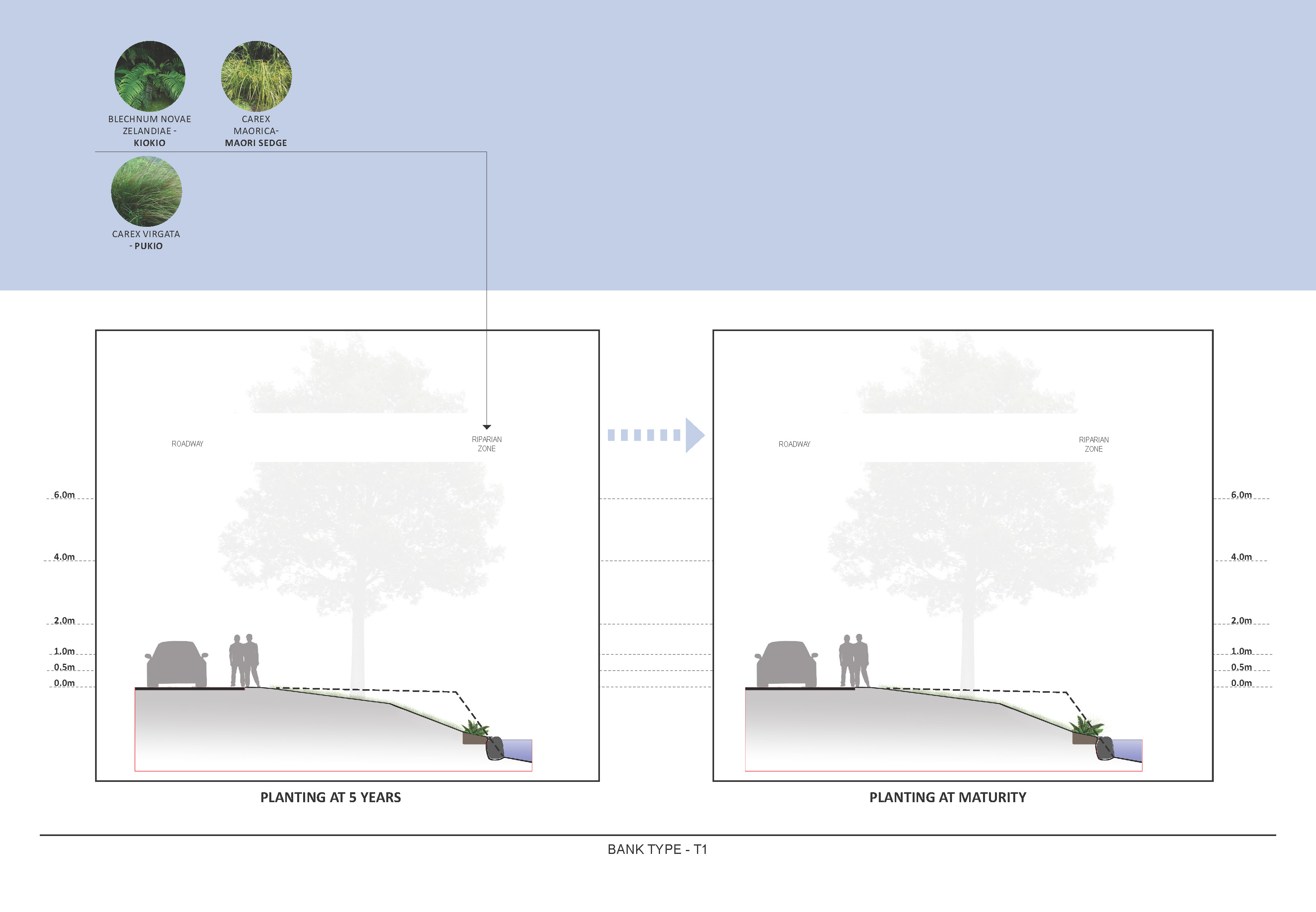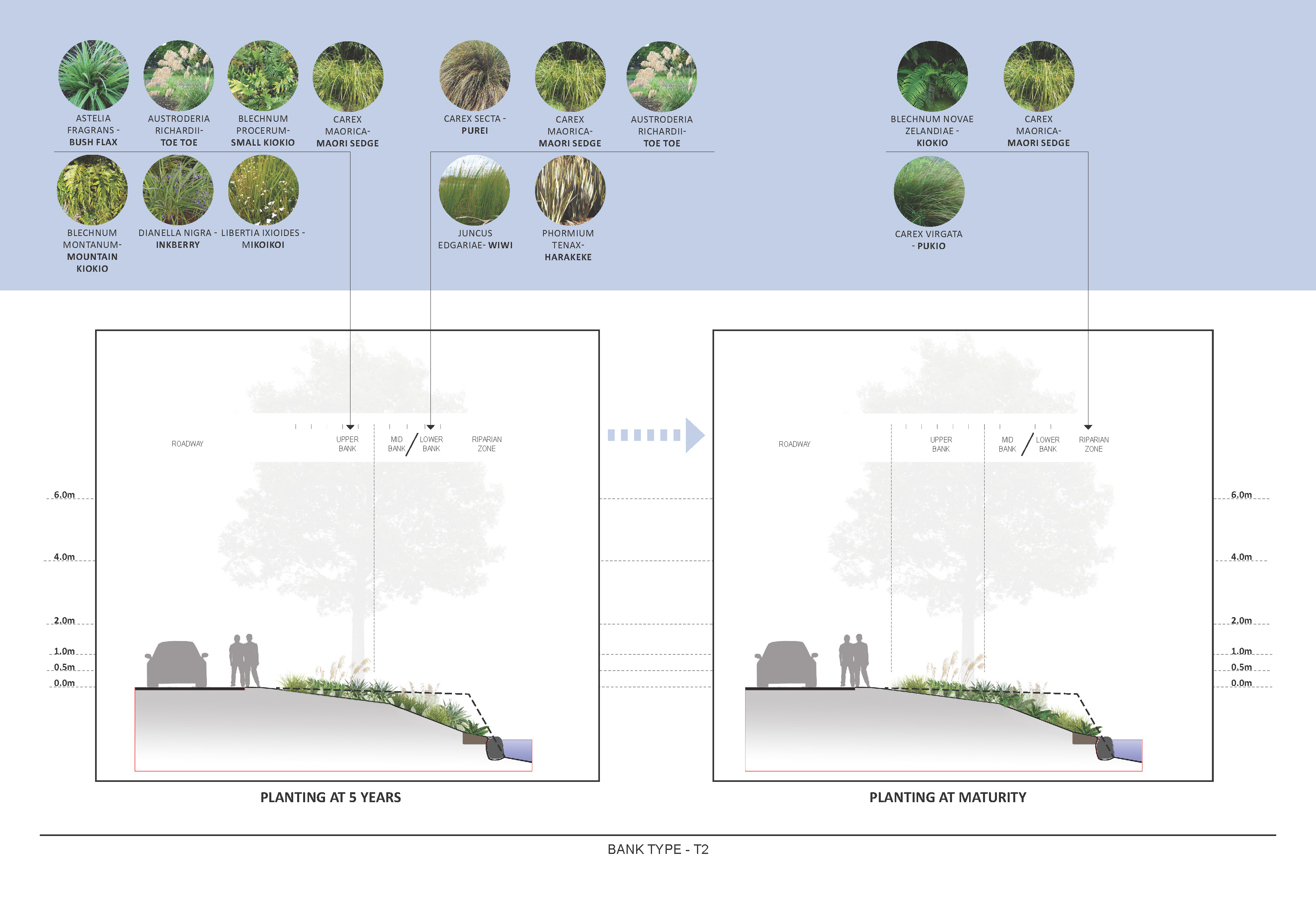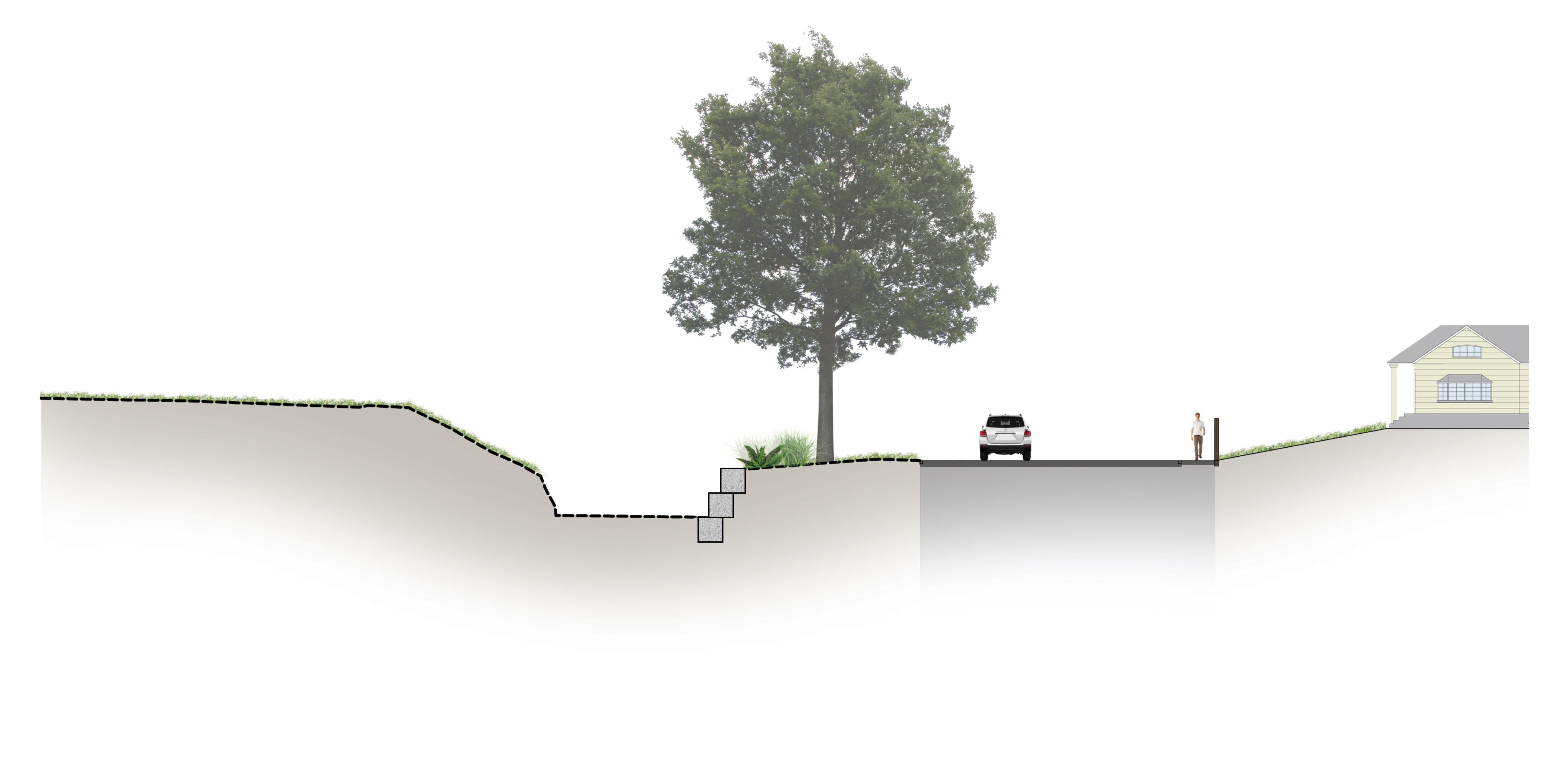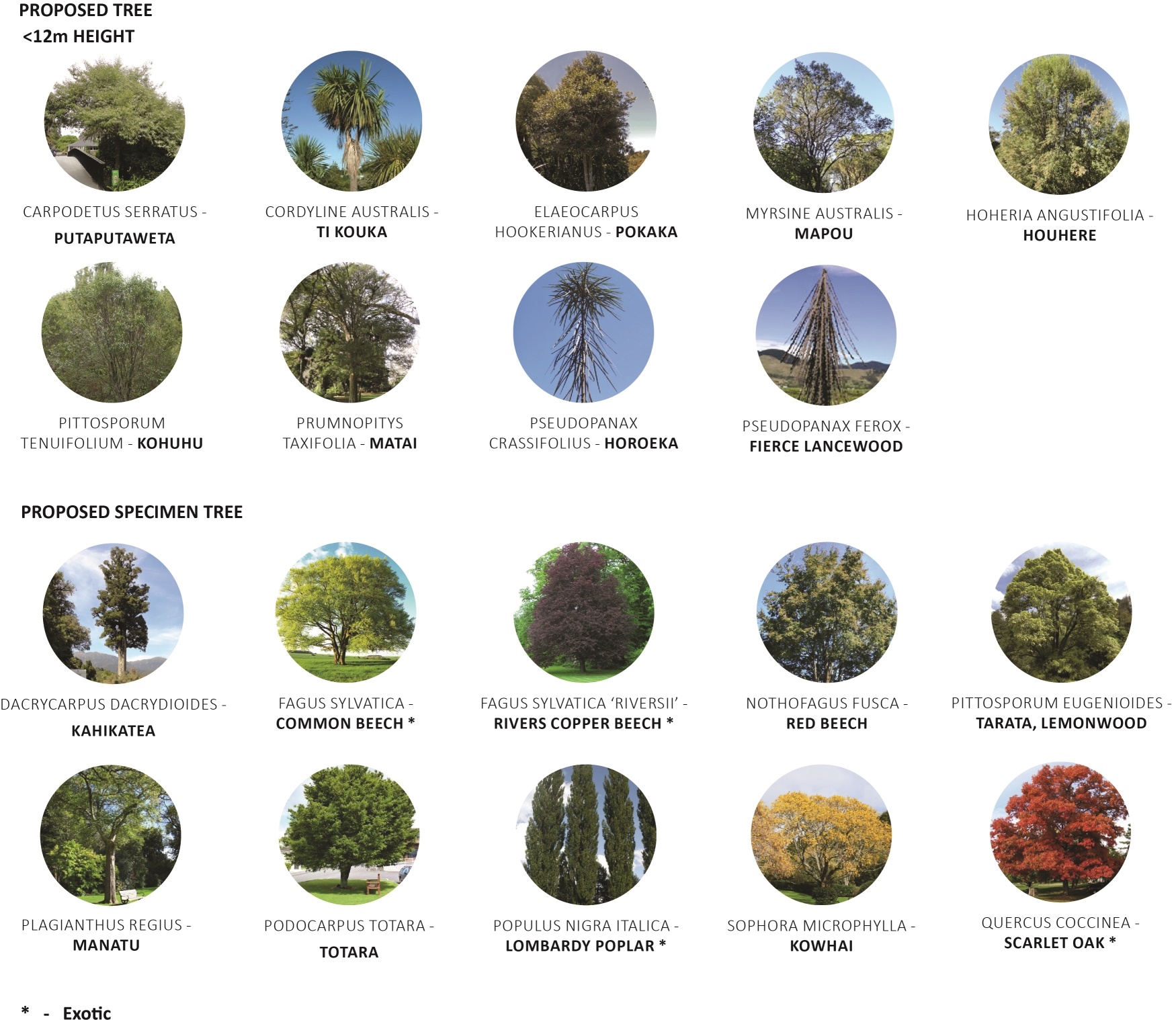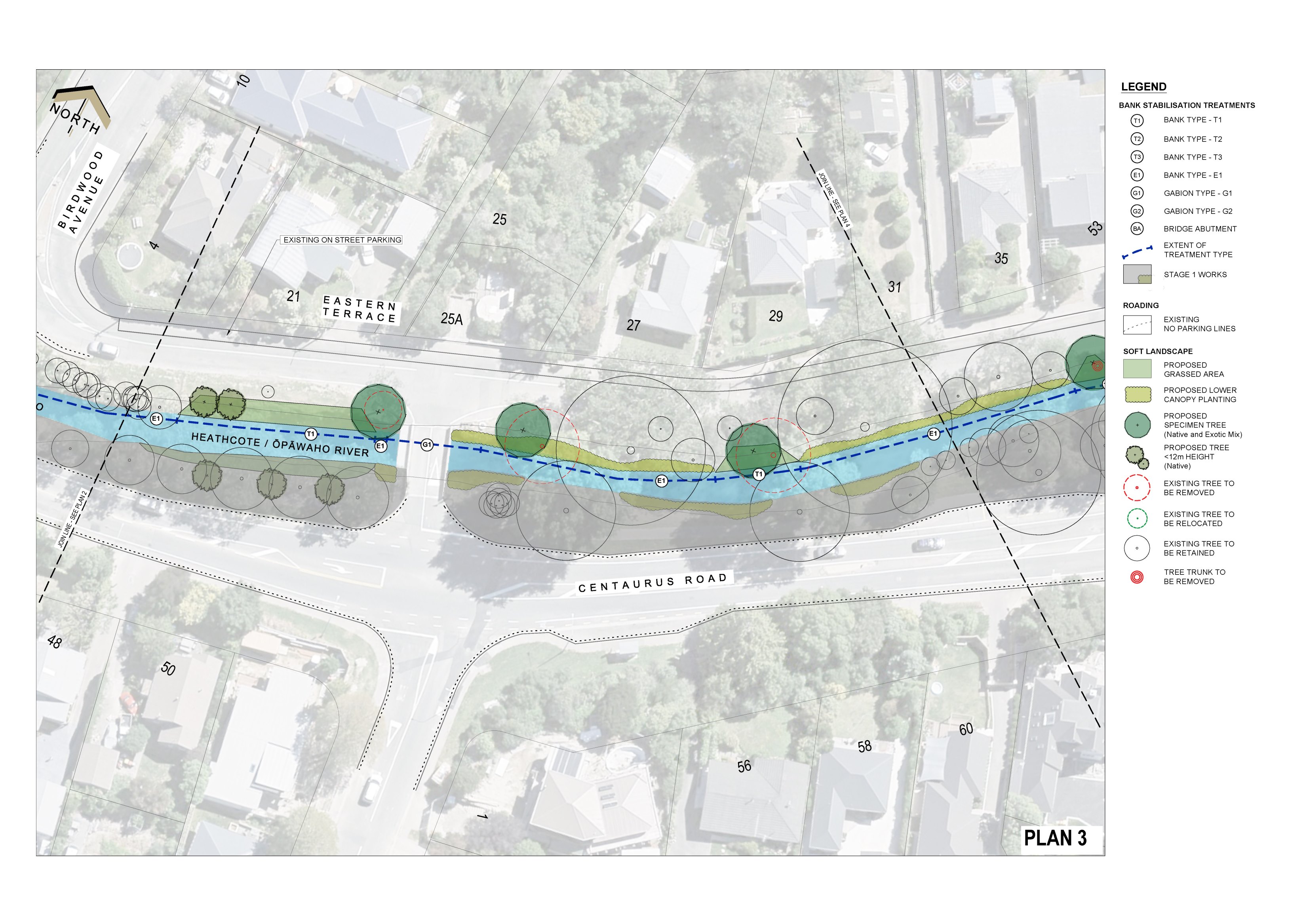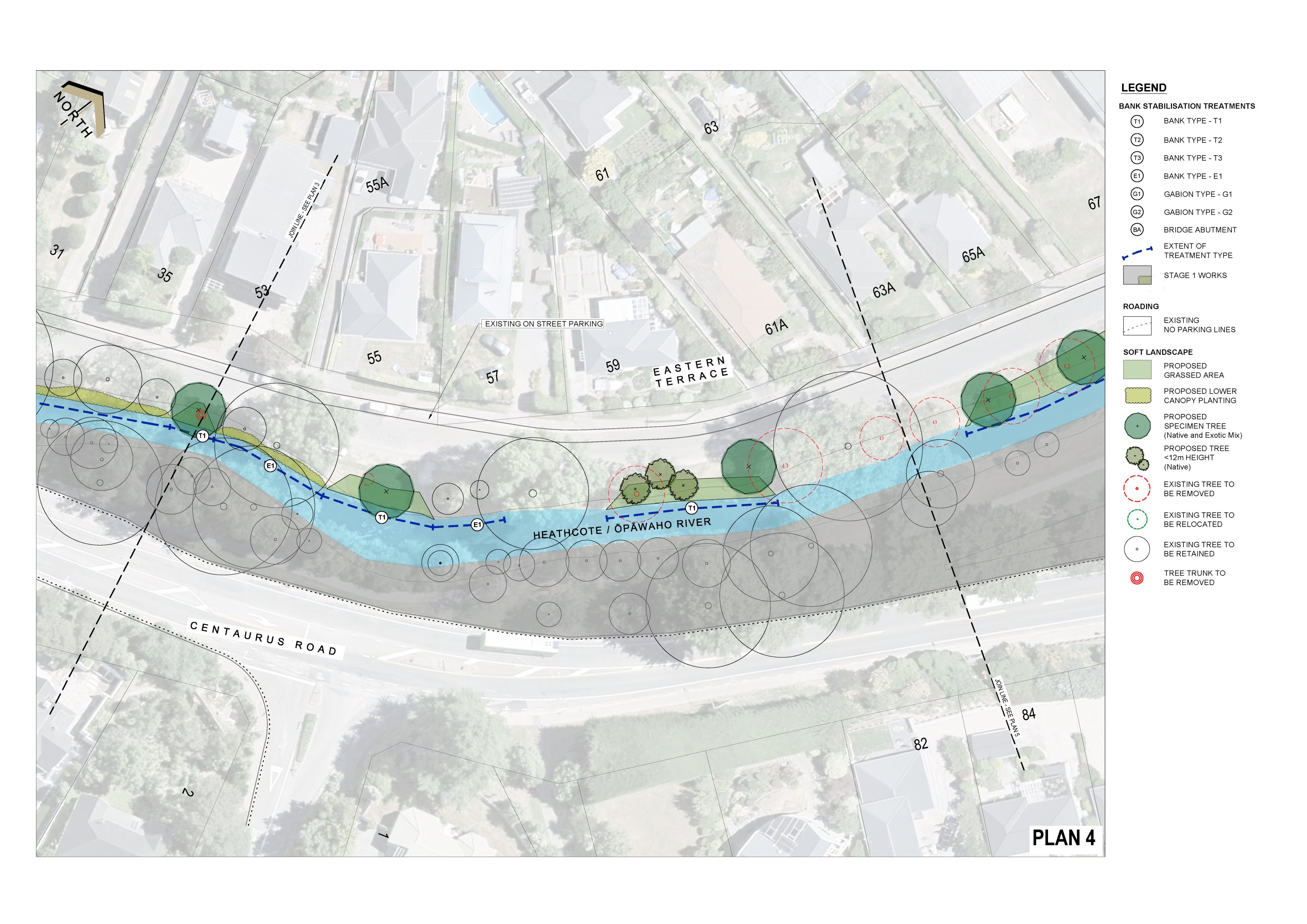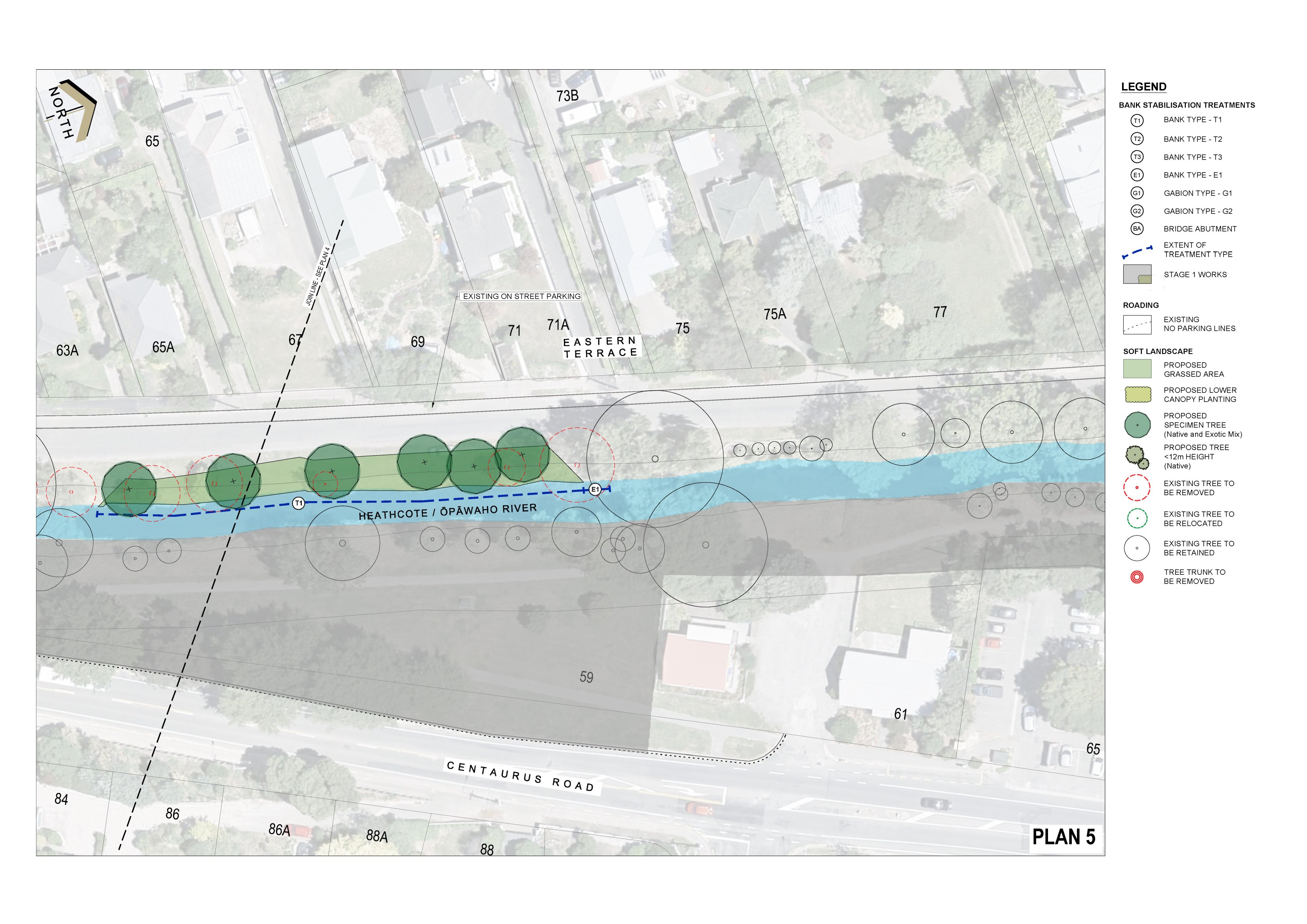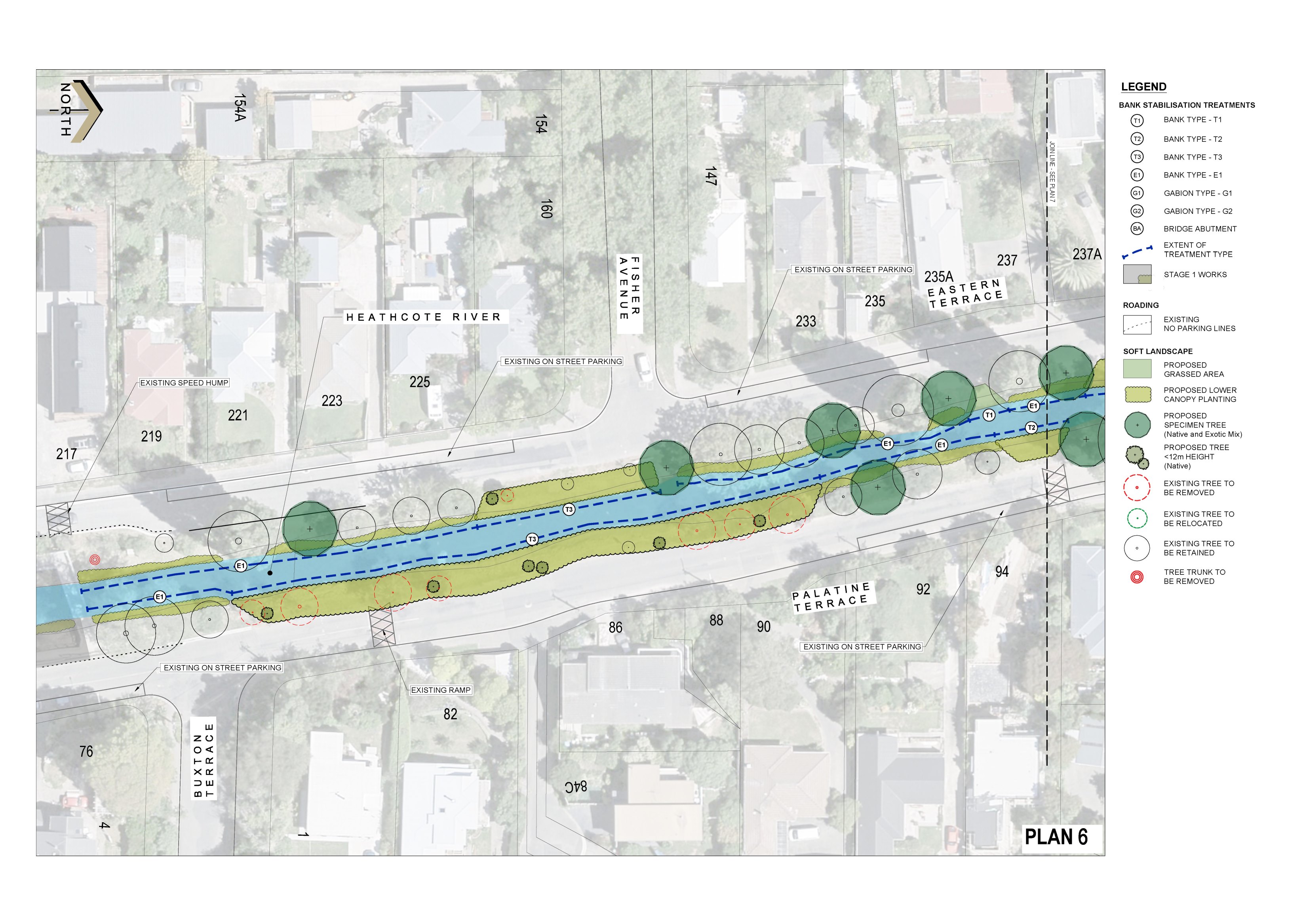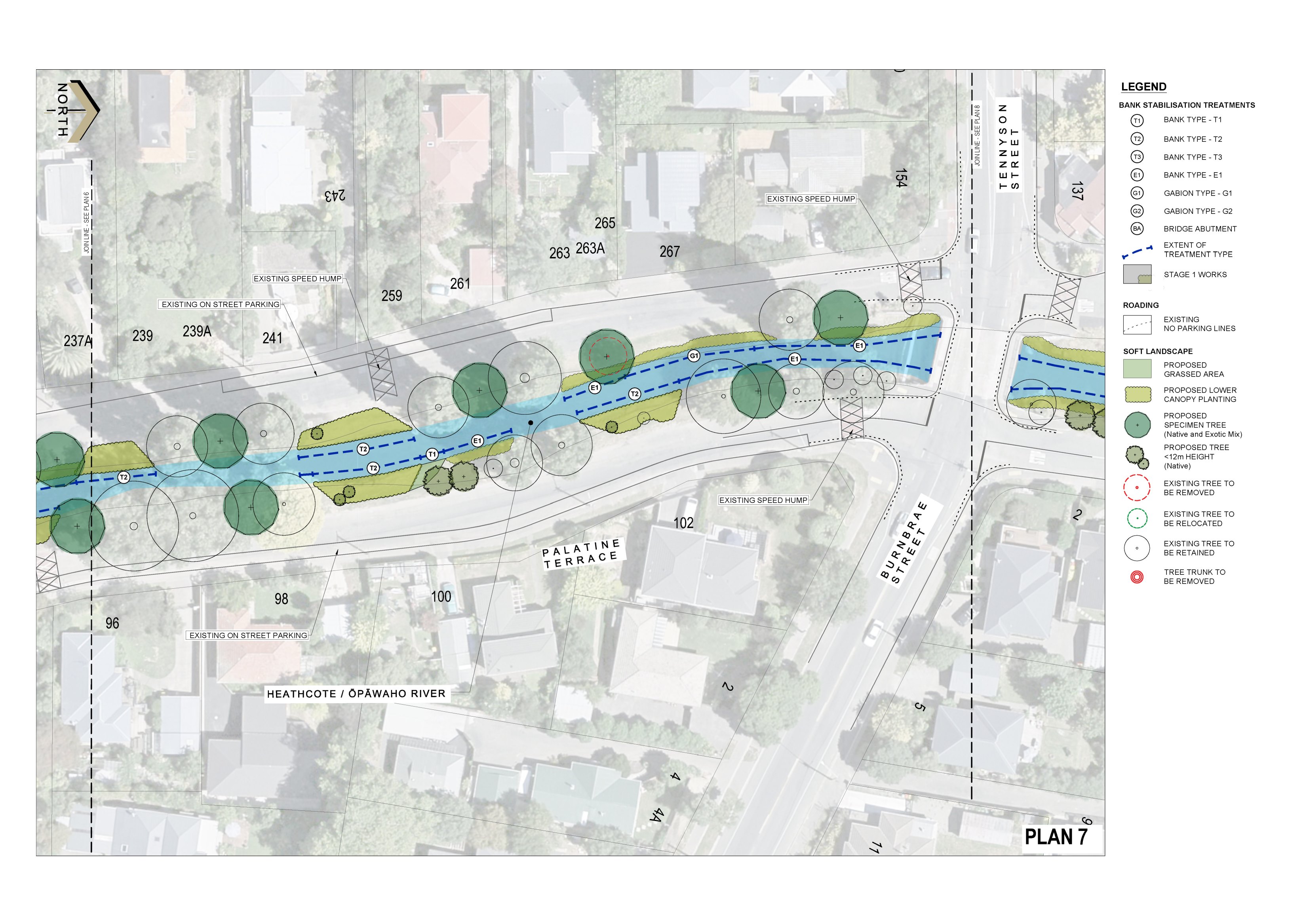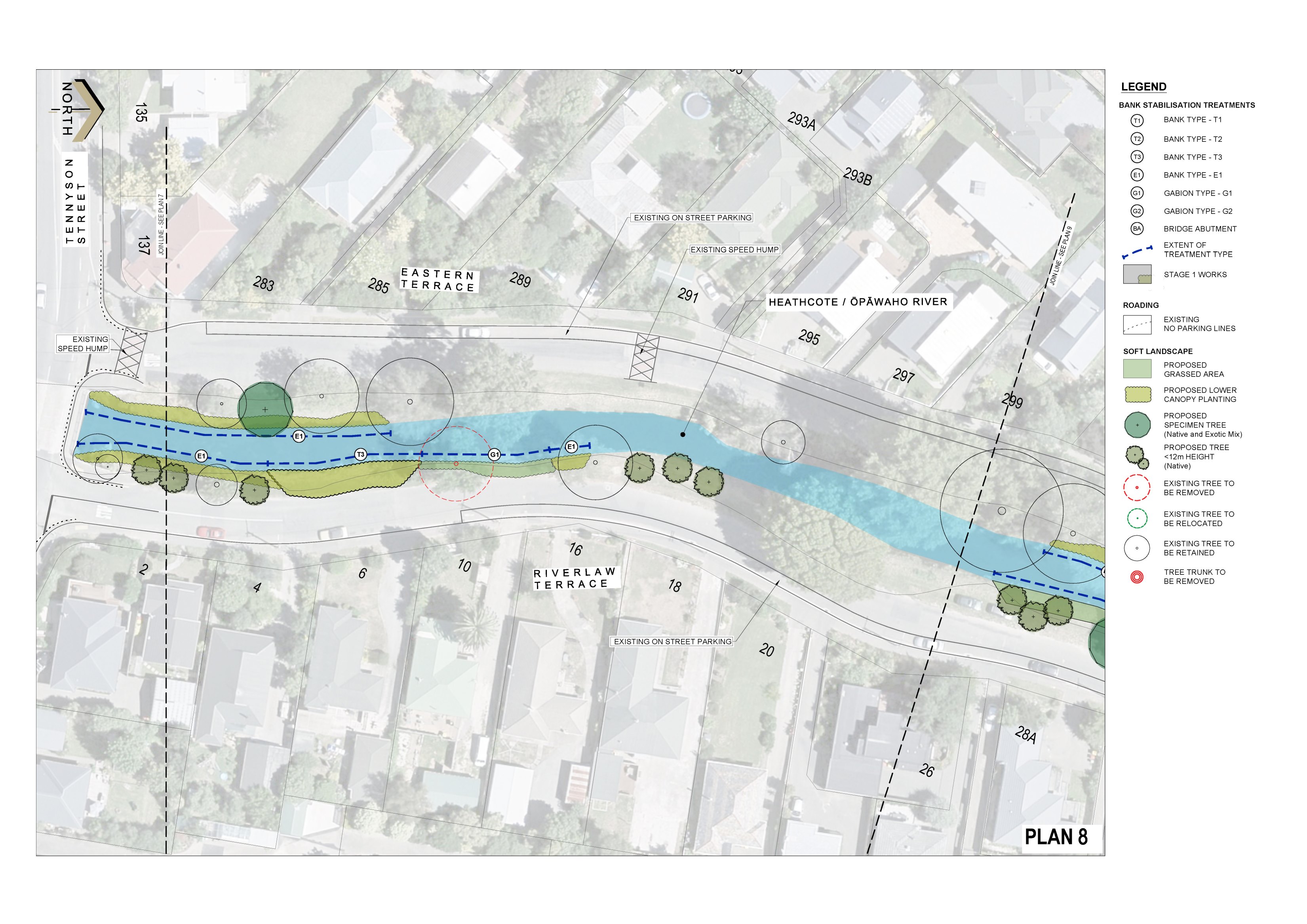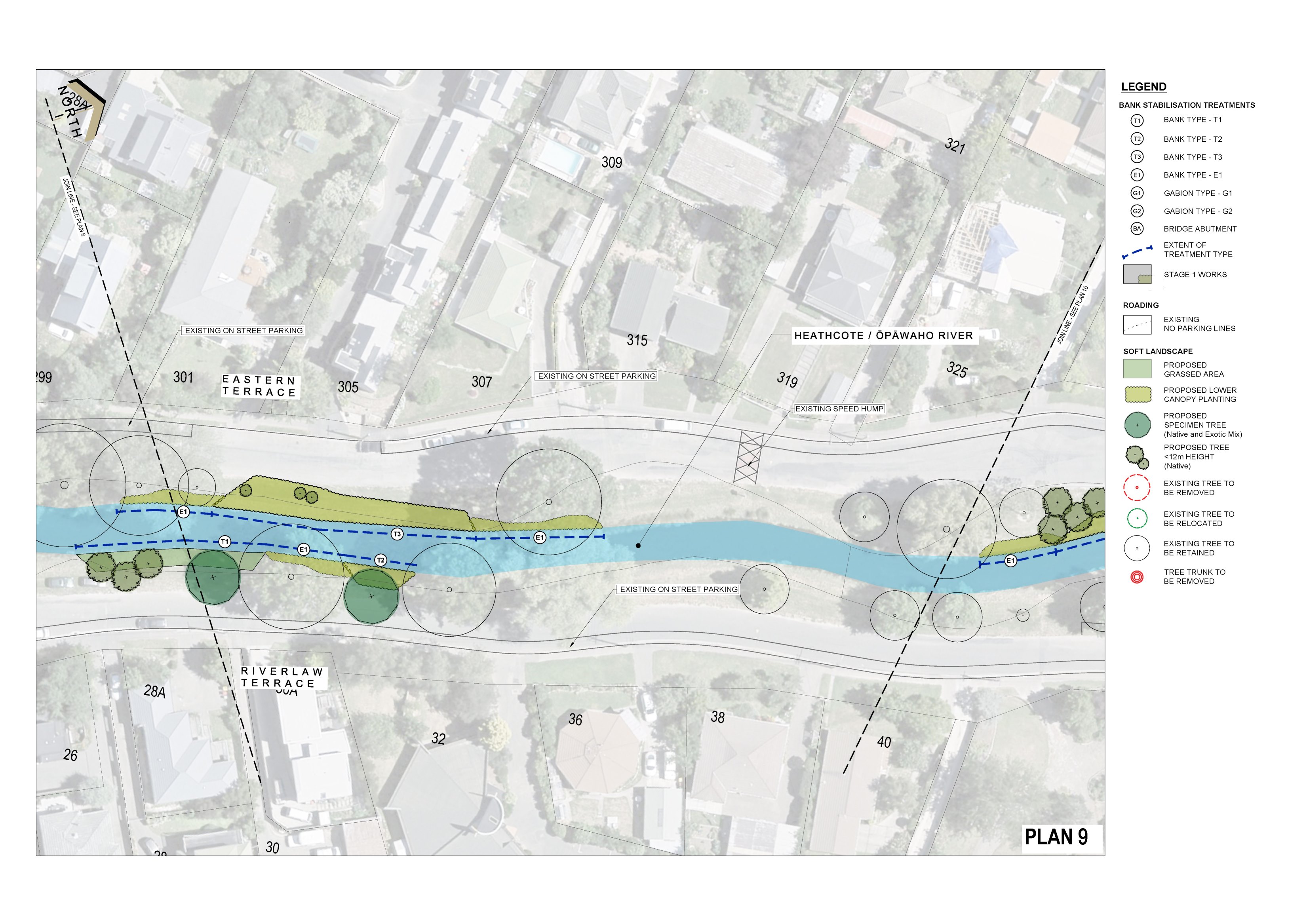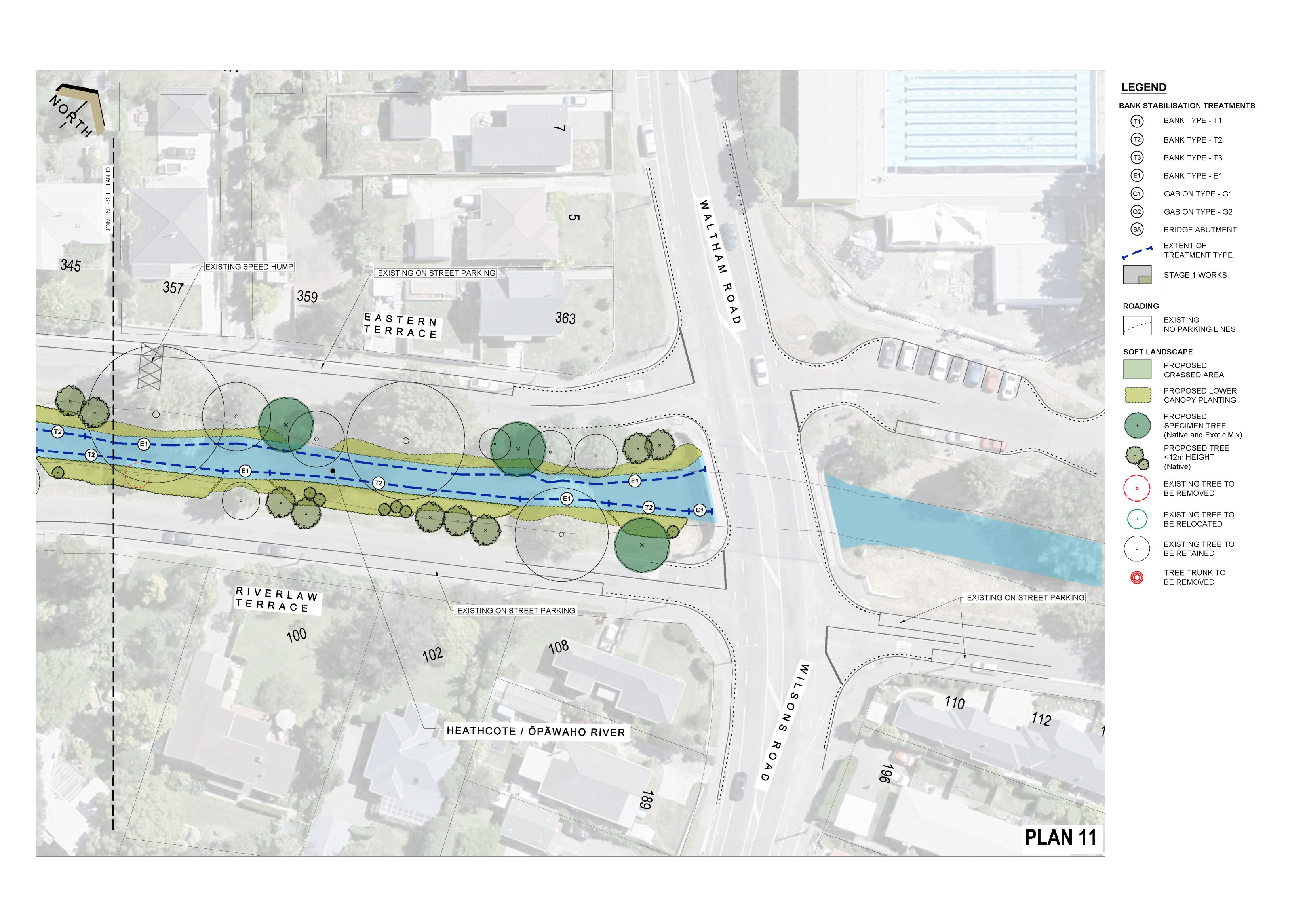Waimea Terrace (#217 to Birdwood Avenue) / Eastern Terrace / Palatine Terrace and Riverlaw Terrace (Buxton Terrace to Wilsons Road)
Share this
Consultation has now closed
Consultation on Ōpāwaho/Heathcote River Bank Stabilisation - Stage 2 has now closed. People were able to provide feedback from 11 July 2018 to 1 August 2018.
During this time we heard from 14 individuals and groups. You can read their feedback [PDF, 335 KB] and also themes identified with a project team response [PDF, 223 KB]
Work on this project is planned to start in late October 2018.
Background
Christchurch City Council (CCC) has been undertaking the Land Drainage Recovery Programme (LDRP) to reduce the risk of flooding and to fix waterways that were affected by the earthquakes. As part of the LDRP, investigations into earthquake damage along the Ōpāwaho/Heathcote River upstream of Radley Street have been undertaken.
The inspections identified a number of areas where the banks are unstable and eroding. While slumping and other instabilities have been a feature of the river for a long time, the earthquakes have accelerated this process and caused more widespread instability than would usually be present. A number of areas were identified as high priority, requiring work within the next 5 years to maintain waterway capacity or prevent further bank failure.
Funding has been obtained to address these high priority areas. The work will proceed in two stages. The first stage is currently under construction. The second stage is now being consulted on.
The stabilisation works need to ensure that the drainage function of the river is improved (through additional capacity and preventing further slumping), while also ensuring that cultural, recreational, ecological, landscape and heritage values are taken into consideration. Therefore, wherever possible, waterway area has been increased by widening the channel. This enables bank stabilisation through a ‘naturalised’ bank profile (rather than hard engineering structures), and increases the capacity of the river. The work will be in keeping with the Mid Heathcote/Ōpāwaho Linear Park Masterplan, which was approved in 2009.
Different types of bank instability require different methods to address the issue. The different designs to be used along the waterway are described in detail in pages 12 to 20, and these designs are then referenced on each plan. To see what is in your area you will need to refer first to the plan, and then look for the detailed description and cross-section of each design type.
The different design types, and length of each type in Stage 2, are:
| Design Type | Length (metres) |
| Bank Type - T1 | 300 |
| Bank Type - T2 | 220 |
| Bank Type - T3 | 220 |
| Edge Type - E1 | 920 |
| Gabion Type - G1 | 65 |
There are a number of common features throughout most designs:
- Preserving trees where possible
- a key trigger of bank instability is erosion and undercutting of the bank toe. To address this instability, a rock edge is proposed in most places
- crevasses and undercutting, while being bad for bank stability, provide habitat for aquatic life. To provide a partial replacement of this habitat, small pipes are proposed within the rock edge, along with planting above the rock edge
- slumping caused by over steepened banks is generally addressed by cutting back the banks to achieve a stable profile. This increases the waterway area of the river, improving the flow
- plantings along the river edge protect the bank to prevent further slumping
- where space is constrained then additional stability works are required, either through a second layer of rocks as a low wall, or in a few limited areas by constructing gabions.
In some areas it is proposed to narrow the road and removesome bankside carparks. This allows drainage capacity to be increased, setting aside space for footpaths and still considering the other community values.
Impacts on trees and landscape planting
Trees provide significant landscape and ecological values to the waterway, and many of the existing trees are providing benefits to bank stability through their roots. The intention is to retain and protect as many healthy and structurally sound trees as possible and increase the existing tree cover within the area, while maintaining stability of the river banks and not impeding water conveyance.
The potential effects of the bank stabilisation works on trees has been quantified as much as possible during the design phase of the project. As part of this, a tree survey has been undertaken to confirm the condition of existing trees and inform the project design.
Amendments to the design may be required due to unforeseen circumstances, especially during construction, which may result in additional tree removals or changes to the proposed tree planting being required.
For new tree planting, final species selection will be dependent on potential variations in site conditions, and availability of tree stock.
The key design principles are:
- In the majority of locations, where a tree is providing good bank stability features, the tree will be retained.
- Where trees are to be retained, minimising the potential effects of the proposed works on existing trees will be allowed for during construction.
- Where there is severe erosion or undercutting, rock edge protection will be placed around the existing root mass of trees that are retained.
- In areas where excavation is required for cutting back the bank and scalloping to the river banks, adequate setback distances will be provided to avoid damage to the root systems of trees that are to be retained.
- Wherever possible tree removals will be limited to unhealthy and structurally unsound trees, and the project will provide opportunities to remove and replace trees in poor condition.
- In some locations, existing site constraints and the extent of works required will result in the removal of healthy and structurally sound trees.
- Relocating young, healthy and structurally sound trees will occur where possible.
Extensive tree planting and landscaping is proposed as part of this project, with the intention of improving the landscape and ecology values of the area in the long term. The new plantings have been designed in alignment with the Mid-Heathcote River/Opawaho Linear Park Masterplan (2009) and Council’s Streamside Planting Guide, with the following aims:
- Implementation of plantings that are suitable to the local environments, especially waterway conditions.
- For all lower bank planting, native species have been selected suitable to the local environment, for low maintenance, good root stability, to enhance the ecology of the river and to minimise potential effects on the waterway capacity and flow.
- Native trees will be planted in groups and as specimen trees where appropriate, and exotic tree species will be planted as specimen trees to complement the existing trees within the area.
- Significant areas of grassing on the banks will occur where the battered slopes are gradual enough in order to maintain access and views of the waterway.
The approximate number of trees to be removed, relocated and new trees to be planted include the following:
| Trees to be Removed: | 27 |
| Small <6m: | 5 |
| Medium 6m-10m: | 15 |
| Large 10m+: | 7 |
| Trees to be Relocated: | 4 |
| Trees to be Planted: | 95 |

Bank type T1 (plans below)
T1 is the most preferred bank profile, but can only be applied where there is sufficient space to cut the bank back to provide a more stable slope and also increase the waterway area. It features:
- Rock edge to protect against bank toe erosion and undercutting
- cutting back the bank increases the waterway area (the dotted line below represents the original bank line)
- small pipes laid into the rocks to provide habitat for aquatic life
- strip of riparian planting overhanging the rock edge to provide shading and habitat for aquatic life. Plant selection is based on both the ability to handle the wet environment, but also they must be low in height and flatten during floods to reduce barriers to flow
- the gentler slope of the bank allows for a grass bank to be maintained.
Bank type - T2
T2 is similar to T1, but due to various constraints (such as the road, or to preserve space for other assets or recreational use) the batter is steeper and so needs to be planted. It also features:
- Rock edge to protect against bank toe erosion and undercutting
- battering increases the waterway area (the dotted line below represents the original bank line)
- small pipes laid into the rocks to provide habitat for aquatic life
- strip of riparian planting overhanging the rock edge to provide shading and habitat for aquatic life. Plant selection is based on both the ability to handle the wet environment, but also they must be low in height and flatten during floods to reduce barriers to flow
- planting of batter is needed to improve stability and for ease of maintenance.
Bank type - T3
T3 is used where space constraints mean that a steeper bank is needed. It includes a small rock wall above a lower bench. This allows the waterway area to be increased (to improve flows) and the profile to be varied to match the space available. It features:
- Rock edge to protect against bank toe erosion and undercutting
- increased waterway area (the dotted line below represents the original bank line)
- small pipes laid into the rocks to provide habitat for aquatic life
- strip of riparian planting overhanging the rock edge to provide shading and habitat for aquatic life. Plant selection is based on both the ability to handle the wet environment, but also they must be low in height and flatten during floods to reduce barriers to flow
- planting of batter is needed to improve stability and for ease of maintenance.
Edge type - E1
E1 is used to preserve an existing mature tree in good health, or where the bank is stable enough currently and does not require cutting back. This type is used to minimise the trees needing removal, but includes succession planting of a new tree further away from the bank to facilitate future bank stabilisation works when stability or the existing tree deteriorates. It also includes:
- Rock edge around existing tree roots to protect against bank toe erosion and undercutting
- small pipes laid into the rocks to provide habitat for aquatic life
- riparian planting overhanging the rock edge to provide shading and habitat for aquatic life, and planting of the bank to improve stability
- preserves the existing canopy which shades the river and reduces weed growth
- planting selected to improve stability and reduce amount of excavation required within tree root zone and to be appropriate for position under a tree canopy.
Location specific design types (G1)
The following types of bank treatment are specifically designed for each location and so a typical cross-section is not able to be provided for each site. This includes gabion walls (structured rock filled baskets) and the treatment around bridge abutments.
A general description is provided of each below.
Gabion type - G1 and G2
Gabion walls are proposed where there are severe space limitations due to existing assets (e.g. roads) or very steep and high waterway banks. They are also used where there are deep slope failures that extend below the river bed.
These include:
- Gabion wall to provide geotechnical stability
- planting above the wall to improve landscape value, and create a natural barrier to the wall for safety. Plant selection based on plants suitable for the river bank environment, with planting beds of 1-2m width
- these are not the preferred treatment due to greater impacts on landscape and ecology. As such the use of these treatments has been minimised as far as possible and measures will be put in place to address impacts (planting, habitat creation).
Bridge abutment – BA
These are location specific treatments around bridge abutments (the base of a bridge). These are to prevent further undercutting of bridges while maintaining the waterway area.
Features of all plans (plans below)
- Where mature trees are stabilising the banks, Edge Type E1 treatment will be used
- gabion Type G1 treatment will be used opposite the stormwater outlet to mitigate erosion to the bank
- new lower canopy bank planting
- where slumping is observed and space is available, Bank Type T1 treatment will be used
- works to address bank instability on the right bank (Centaurus Road) were included in Stage 1 of this project
- no works proposed where large mature trees are providing stability benefits, and no critical erosion is observed. This maintains the existing ecology and landscape amenity the tree and minor undercutting provides.
Location specific features
Plan 1
- One tree opposite 223 Waimea Terrace requires removal for bank stabilisation works and its poor condition
- two new specimen trees
- works to address bank instability on the right bank (Sloan Terrace and Centaurus Road) were included in Stage 1 of this project
- rock toe to be rebuilt opposite the stormwater outlet.
Plan 2
- Two trees require removal due to the bank stabilisation works and their poor condition. These are located outside 229 and 231 Waimea Terrace
- three new specimen trees and two smaller growing native trees are proposed.
Plan 3
- Waterway to be realigned upstream of the Bowenvale Bridge using Bank Type T1 treatment
- the Stage 1 realignment on the Centaurus Road bank has provided additional bank area on the Eastern Terrace side to be used for stabilisation
- through the Bowenvale Bridge, Gabion Type G1 treatment will be used to address the bridge abutment stability and tie-in to the realigned upstream bank
- three trees require removal due to the bank stabilisation works and their poor condition. These are located outside 23, 25 and 29 Eastern Terrace
- three new specimen trees and two smaller growing native trees.
Plan 4
- Four trees require removal due to the bank stabilisation works and/or their poor condition. These are located outside 55, 59 (2) and 61 Eastern Terrace
- removal of the stump outside 53 Eastern Terrace
- three new specimen trees and three smaller growing native trees.
Plan 5
- Six trees require removal due to the bank stabilisation works and/or their poor condition. These are located outside 63 (x2), 65, 67, 69 and 71 Eastern Terrace
- six new specimen trees
- works to address bank instability north of Palatine Terrace to the Buxton Terrace pedestrian bridge, were included in Stage 1 of this project.
Features on all plans (plans below)
- Where mature trees are stabilising the banks, Edge Type E1 treatment will be used
- where slumping is observed, but space is restricted due to the existing road and infrastructure, Bank Type T3 treatment will be used
- where slumping is observed and space is available, Bank Type T1 treatment will be used
- new lower canopy bank planting
- E1 treatment will extend to tie in to the existing bridge structure at Tennyson Street
- gabion Type G1 treatment will be used on the outside bend of the waterway to protect the existing road and wastewater infrastructure, and due to space restriction
- no works proposed where large mature trees are providing stability benefits, and no critical erosion is observed. This maintains the existing ecology and landscape amenity the tree and minor undercutting provides
- edge Type E1 Treatment will be used to tie in to the existing rock toe protection upstream
- where slumping is observed and space is available, Bank Type T1 treatment will be used, otherwise Bank Type T2 treatment will be used and planting provided to improve stability.
Location specific plans - Eastern Terrace
Plan 6
- One tree outside 160 Fisher Avenue requires removal for bank stabilisation works, and two trees require relocating
- removal of the trunk outside 217 Eastern Terrace
- four new specimen trees and one smaller growing native tree.
Plan 7
- One tree opposite 265 Eastern Terrace requires removal for bank stabilisation works
- five new specimen trees and one smaller growing native tree.
Plan 8
- One new specimen tree.
Plan 9
- Three smaller growing native tree.
Plan 10
- One new specimen tree and nine smaller growing native trees.
Plan 11
- Two new specimen trees and four smaller growing native trees.
Palatine Terrace
Plan 6
- Seven trees require removal due to the bank stabilisation works and/or their poor condition. These are located outside 1 Buxton Terrace (3), 82 Palatine Terrace, 88 Palatine Terrace, and 90 Palatine Terrace (2)
- one new specimen tree and six smaller growing native trees
- one tree outside 86 Palatine Terrace requires relocating due to the bank stabilisation works.
Plan 7
- Three new specimen trees and five smaller growing native trees.
Riverlaw Terrace
Plan 8
- Where significant slumping is observed and the bank height is relatively high, Gabion Type G1 treatment will be used. Space is limited in these areas, and the area near the intersection of Tennyson Street means road narrowing or battering is not feasible for safety reasons. Edge Type E1 Treatment will be used to tie in to the existing rock toe protection downstream (and on opposite bank)
- one tree opposite 10 Riverlaw Terrace requires removal for bank stabilisation works
- six smaller growing native trees.
Plan 9
- Two new specimen trees and three smaller growing native trees.
Plan 10
- Two new specimen trees.
Plan 11
- One tree opposite 90 Riverlaw Terrace requires removal for bank stabilisation works and its poor condition
- one new specimen tree and twelve smaller growing native trees.
Come and meet the team
Monday 23 July 2018
Anytime between 4pm – 6pm
Boardroom, Beckenham Service Centre, 66 Colombo Street, Christchurch


